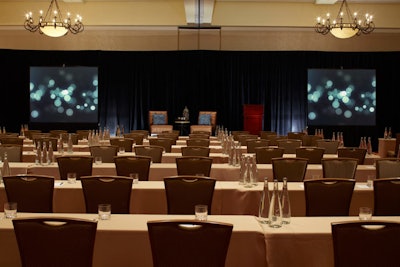
Classroom, theater, banquet: those are three of the most common room layouts for education sessions and meetings. But are they the most effective if your goal is to create a worthwhile experience for your attendees? Jeff Hurt, executive vice president of Velvet Chainsaw Consulting, and Joan Eisenstodt, owner of Eisenstodt Associates, agree the answer is a resounding no.
“Most conferences are about efficiency of transfer of information. They are not about effectiveness of learning,” Hurt said. "So if it’s just about the information leaving the speaker’s mouth and hitting the attendees’ ears, do what you’ve always done. But if you want learning to occur, if you want improvement in attitude, behaviors, and skills, then you must change the way you do things."
For large general sessions, planners should consider putting the stage in the middle of the audience for a theater-in-the-round design. This layout creates a greater sense of intimacy for attendees, even in a room with hundreds of people. One challenge: speakers may need training to become comfortable presenting in that environment.
Smaller sessions offer greater opportunities for creativity and designs that encourage learning. “The neuroscience shows the more you talk about something, the more you actually retain that information and the more you begin to apply it and process how it connects with your situations,” Hurt said. "The rule of thumb is the smaller the group, the more likely you are to participate and discuss. If you are sitting at a round of 12, one person talks while 11 people listen. If you are in a pair, there is extremely high likelihood you will take turns talking to one another."
To boost interactivity, Eisenstodt urges planners to consider the needs of the audience. “People need options. So I love a room with a few different styles in it—some theater, some cocktail tables, some highboys, some rounds, some soft furniture—and have it placed so people can move around when they are bored,” she said. “And give them permission at the start to get up and move, or to leave the room if it’s not working for them.”
The type of furniture can also impact the attendees’ experience. “Informal furniture such as couches, love seats, and comfortable chairs are great for informal discussion, but they are terrible for reflective thought and brainstorming. If you want effective brainstorming, the research shows uncomfortable furniture is best—stools and beanbag chairs and cubes. They actually aid in helping you be more creative and brainstorm more solutions than a traditional round table or theater seating or informal seating,” Hurt said.
Planners should also consider lighting. Improvements in audiovisual equipment and presentation technology mean that lights no longer need to be dimmed for effective viewing. Brighter room lighting not only helps attendees stay alert, but it also sends a subtle message that they should be participating actively rather than passively.
Eisenstodt acknowledged there are still two barriers keeping some planners from trying new layout concepts: budget and venue. “The way many hotels and convention centers are designed is not even remotely conducive to that collaborative space. We are dealing with hotels that have formulas that tell us how many people can go in a room, and if we don’t do it that way we are charged,” she said.
Additional things to keep in mind when planning room layout include whether attendees need a table or surface to place mobile devices, and whether they need access to a power source.



















